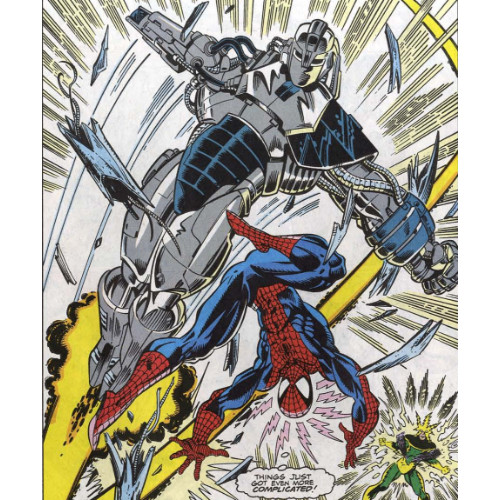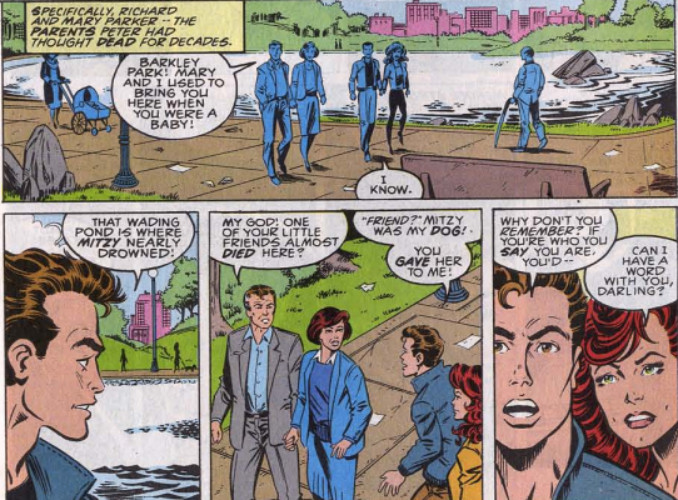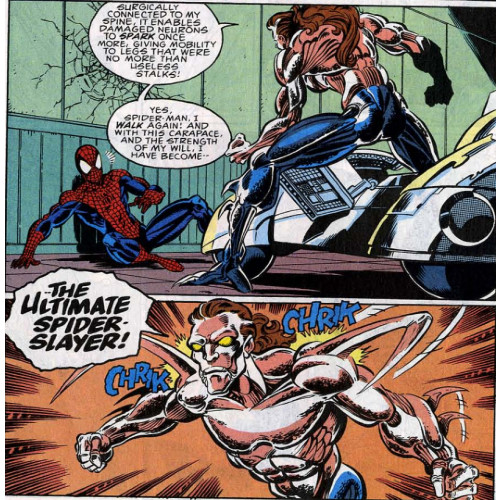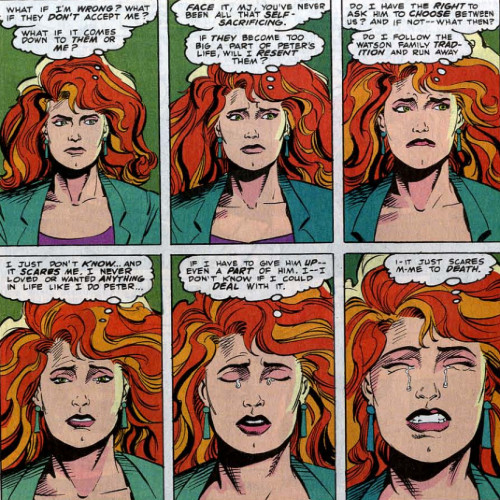Spider-view: "Invasion of the Spider-Slayers" (The Smythe Saga, Part 1)
Though heavily action-oriented, this six-parter dials up strong characterization in back-up strips as a central mystery deepens
—by Nathan on August 17, 2024—

In Amazing Spider-Man #25, Stan Lee and Steve Ditko introduced readers to a man named Spencer Smythe, an inventor who sold J. Jonah Jameson on a seemingly foolproof method of defeating Spider-Man: the Spider-Slayer! Contrary to its name, the initial design was less than lethal, purely intended to capture Spider-Man so Jameson could finally unmask the Web-Head. The robot was defeated in its first encounter with Spidey, as were subsequent–and more lethal!–versions. Smythe eventually died of radiation poisoning from the materials he handled in constructing the Wall-Crawler-killers, his obsession driving him to the grave.
His son, Alistair, inherited that obsession, and after failing to murder Spider-Man in their first match, was left crippled. A second defeat was just as ignominious. But perhaps third time's the charm? Alistair Smythe, son of the original Spider-Slayer creator, has returned…and at a particularly problematic time for Peter Parker.
Like other "series within a series" I have tackled, such as "The Image Review-lution" and "The Osborn Prelude," I intend to use this blog to kickstart a series of reviews analyzing appearances of the sinister Spider-Slayers leading up to this issue, told exclusively through "Crawling Back" after this inaugural post.
So let's get slayin'.
"Invasion of the Spider-Slayers"
Writers: David Michelinie (main story and back-up strips); J.M. DeMatteis, Al Milgrom (back-up strips)
Pencilers: Mark Bagley (main story); Aaron Lopresti, Tod Smith (back-up strips)
Inkers: Randy Emberlin (main story); Aaron Lopresti, Don Hudson, Mark Stegbauer, Tod Smith (back-up strips)
Colorists: Bob Sharen (main story and back-up strips); Marie Javins (back-up strips)
Letterers: Rick Parker, Dave Sharpe, Richard Starkings (main story); Steve Dutro, Joe Rosen, Jon Babcock (back-up strips)
Issues: Amazing Spider-Man #368-373
Publication Dates: November 1992-January 1993

A few "Spider-View" posts ago, we examined an ASM narrative which marked a startling turn in the ongoing saga of our friendly neighborhood Peter Parker: the return of his parents! Believed dead for over twenty years, Richard and Mary Parker showed up unexpectedly at Aunt May's house one day, causing all kinds of turmoil for poor Peter. Digging into their story–that the couple had been held as political prisoners overseas the last two decades–Peter appeared to confirm their story…though he, and others as we shall see, have their doubts.
That "doubt" is a critical theme across these issues, providing Michelinie the internal tension necessary to cause friction, which he layers on fairly well. At moments, Peter himself–who, though his doubts were seemingly assuaged in the last arc, still finds himself tempted to not fully trust who his parents say they are–is a tad too vocal about this, in my opinion, confronting his parents openly in public as to their identities. MJ serves as a voice of reason, but even she questions if Richard and Mary are the genuine articles. May, too, in one of the back-up strips written by J.M. DeMatteis, offers her own concerns.

Other emotions are allowed to flit across the pages. MJ, specifically, internalizes the tension she feels and knows Peter is under; choosing not to discuss it, she turns to cigarettes, a symbolic representation of her feelings. I don't recall how long the "MJ smokes" subplot runs, but it's an interesting turn for a character who, in several stories I've reviewed, boils down to "Spider-Man’s wife who worries about Spider-Man." Yes, her concerns are integrally tied to Peter's, but her expression here is more personal. Instead of lashing out at Peter with another "Being Spider-Man is dangerous!" tirade, she turns away, steps outside, and lights a cigarette. She believes she can stop at any moment and that denial gives her a semblance of power and control. When a college cafeteria staff member tells her she can't smoke inside, she cuts him off, claiming her need overrides his. It's rude, yes, but it's a surprisingly defiant moment for MJ, who has so long been the fun-loving, party girl who just wants to assure everyone she's okay.
Micheline largely balances the mystery behind the Parkers' return with our cast's doubts, crafting a decent enigma that leaves the reader pondering what's real. With hindsight for anyone who knows the ending to this particular arc, the truth is apparent from the jump, and reading it through that lens, I found I generally appreciated how Micheline handles the material. He creates enough room for our characters' to wrestle with their emotions regarding the dramatic return, and by the end of the six-issue arc, has done enough, I'd argue, to craft a decent transition from doubt to greater trust. We believe that our protagonists believe that Richard and Mary Parker are who they say they are, hindsight notwithstanding.

Built into this ongoing mystery surrounding Mr. and Mrs. Parker is a second helping of generational conflict. Micheline brings back Alistair Smythe, who first fought Spider-Man in Amazing Spider-Man Annual #19. As I noted in the intro, Alistair was left crippled by his encounter with Spidey and has, years later, transformed himself into what he calls "the Ultimate Spider-Slayer." The reveal of Smythe as a Slayer himself is dramatic–again, spoiled for me, somewhat, by his inclusion in the 90s Spider-Man animated series–predicated on a series of failed attempts to kill Spidey with robotic slayers more dangerous that his father's or his own previous robots. In transforming himself into a mechanized monster capable of killing Spidey, Smythe has crossed a line his father never dared breach, taking Dad Dearest's deadly obsession even further. The transformation feels like an oddly natural extension of the Smythe family feud with Spidey, reminiscent of another generational conflict where one goblin-garbed ghoul replaced his father after the latter's own demise. Smythe never blatantly references he's attempting to kill Spidey in his father's name, as their previous two tassels has ignited a personal hatred for the Web-Head, but Spencer's specter lingers over their conflict.
Though Peter and Alistar eventually grapple, Michelinie and Bagley both seem to relish in pitting Spidey against various mechanized killing machines…and a few other surprising foes. This six-issue saga is jam-packed with physical fights as Spidey tussles with deadlier and deadlier machines–a razor-winged bat robot, a three-faced Slayer that isn't the Tri-Sentinel, and an armored powerhouse Spidey jokingly calls "Dark Iron Man"–and if I were to critique Micheline on one thing in these issues, it's the rapid pace between action sequences. We're given decent hints of story as to the developing mystery behind the Parkers, but some of these are relegated to back-up strips, and I wonder if Michelinie and Bagley hadn't been as gung-ho about the constant kerfuffles, we may have been given even more context and clues.

But the fights are fun and that intersection between story and skirmishing is the sweet spot most comics try to hit. Michelinie just seems a little imbalanced here, favoring the fighting. We are given a few bombastic brawls as Spidey squares off against a few members of his rogues gallery, such as Electro and the Scorpion, who become unwittingly involved in the "invasion" aspect of the story. And Bagley is given free reign to design a wealth of adversaries, including one Slayer which looks like a robot designed by Mendell Stromm, which I found personally gratifying. It's generally a good day when a writer chooses to loop the Robot Master, of all people, back into Spidey's sphere. For a guy who lasted a single issue before dying during the Lee/Ditko era, Stromm has a surprising longevity; heck, this isn't the last time his presence will be felt during a controversial 90s arc, and double heck, he appeared most recently during Nick Spencer's ASM run!
Anyway, thanks for the geeky digression.
The back-up strips that I've mentioned–three written by J.M. DeMatteis, two by Al Milgrom, and one by David Michelinie–mostly add extra layers of characterization on the ongoing story. DeMatteis' tales focus on J. Jonah Jameson, Harry Osborn, and Aunt May, giving their insights into the unfolding drama with May and Richard. DeMatteis, as is often his prerogative, develops standout, character-driven narratives, genuinely honing in on how each of these characters handle the situation and how their reactions are tied into their backstories. May, for example, feels kinship with Peter, wondering how she would feel if her own absentee father showed up again in her life, and Jameson tries to discern how to make some money off the Parkers' story (naturally). Milgrom offers a pretty well-told perspective through MJ's eyes, her current experiences deeply tied into her own childhood expressed against the backdrop of acting out a scene, creating a unique scaffolding for her emotions to play out against, with nary a cigarette in sight. Michelinie is really the only writer who drops the ball, if I can be slightly unfavorable for a second–his plot, focused on Venom, is really intended to further an upcoming arc of his featuring the villain. But, hey, five out of six back-up strips recommending a dose of supporting cast characterization is fairly solid.

So the mystery has more wrinkles, much like Richard and Mary's faces. Are they who they say they are? Are the Parkers right to lean into their trust of the two? This plot will simmer for a while: I'm about 6 ASM-centric "Spider-view" posts away from the conclusion, but considering how often I diverge from this series to write about the Sinister Six or the Green Goblin or the post-Crisis DC Universe, it may take a while to get there. So enjoy the fragments as we slowly piece this perilous Parker puzzle together.